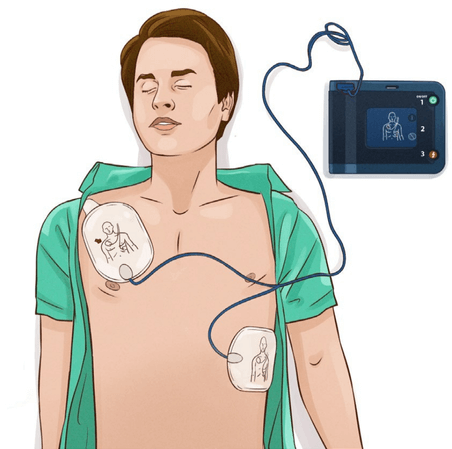4.6 AED for Infants and Children Under 8 Years
How an AED Works
An Automated External Defibrillator (AED) analyzes the heart’s rhythm and determines whether a shockable rhythm is present. If needed, the AED delivers an electrical shock to the heart, temporarily stunning it and giving it a chance to reset.
This reset may allow the heart’s natural pacemaker to restore an organized rhythm. When CPR is continued after the shock, the heart may resume effective contractions — a return to circulation known as Return of Spontaneous Circulation (ROSC).
Using an AED on Infants and Children
Many AEDs can be used for both pediatric and adult patients. Pediatric-capable models reduce the energy delivered during defibrillation. Always follow the manufacturer’s instructions for pad placement and settings.
Step-by-Step AED Operation
- Power on the AED. Open the case and turn it on, if required.
- Select the correct pads:
- Use pediatric pads for children under 8 years or under 55 lbs (25 kg).
- If pediatric pads are not available, use adult pads — just make sure they do not overlap or touch.
- Expose and prepare the chest:
- Ensure the chest is bare and dry. Wipe away sweat or moisture.
- Apply the AED pads:
- Follow the pad diagrams or verbal prompts.
-
Front-and-back placement (Infant or Small Child)
×Front-and-back placement (Infant or Small Child)
 © FAW Training Solutions – All rights reserved
© FAW Training Solutions – All rights reserved- Place one pad in the center of the chest, between the nipples.
- Place the second pad on the back, between the shoulder blades.
-
Front placement (Child)
×Front placement (Child)
 © FAW Training Solutions – All rights reserved
© FAW Training Solutions – All rights reserved- Place one pad on the upper right chest, just below the collarbone.
- Place the other pad on the lower left chest, below the armpit.
- Ensure both pads are firmly attached to the skin and do not overlap.
- Connect the pads to the AED (if required).
- Clear the victim and let the AED analyze.
- Do not touch the victim during analysis.
- Some AEDs start analysis automatically; others require you to press a button.
- If a shock is advised:
- Ensure everyone is clear of the victim.
- Loudly announce, “Clear the victim!” or “Everybody clear!”
- Visually confirm that no one is touching the victim.
- Press the shock button (if required) or allow the AED to deliver the shock automatically.
- Immediately resume CPR after the shock, or if no shock is advised.
- Begin chest compressions followed by rescue breaths (15:2 if two rescuers).
- Continue cycles of CPR and AED analysis:
- After about 2 minutes (5 cycles), the AED will prompt another rhythm analysis.
- Follow prompts and repeat the process as needed.
Important Notes
- Never delay defibrillation while waiting for pediatric pads.
- Do not place pads over implanted devices (e.g., pacemakers).
- If using adult pads on an infant, always use anterior–posterior placement (front and back).